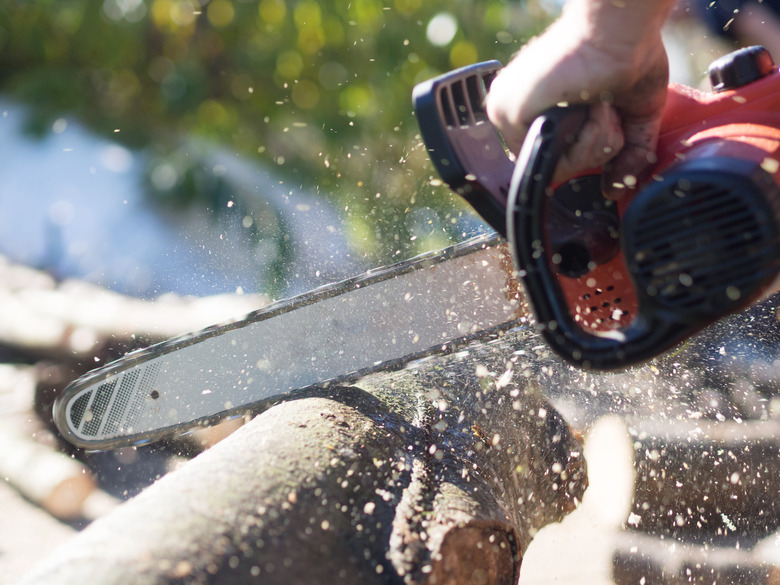My Chain Saw Is Not Getting Gas
Having your own chain saw can be incredibly helpful when it's time to do more intensive lawn and yard work, but despite their use in a lot of rugged, messy jobs, chain saws are more sensitive machines than many owners realize. It can be incredibly frustrating when it fails to start, especially if you've invested in a high-quality, top-of-the-line tool. Thankfully, a chain saw failing to start is a common problem with generally simple solutions. There are a variety of ways to solve the issues that are causing your chain saw to fail and a few good practices you can follow to avoid having the problem in the future.
Chain Saw Basics
Chain Saw Basics
Nearly all of the mechanics and functions of a chain saw are built around the firing of its engine. If the engine isn't chugging along, the assembly of gears that pull the chain you use to cut won't work. So, if your gas chain saw isn't starting, it's likely that gas isn't feeding into the engine properly.
Before you start troubleshooting, however, it's worth knowing just how the chain saw's engine works. A gas-powered chain saw's engine functions much like that of a car. Simply put, the piston that drives the gears and chain is powered by energy released by combustion. Fuel in the tank is mixed with air when it's pulled into the carburetor where it's then ignited by a spark from the spark plug.
If your chain saw isn't getting gas, the trouble most likely lies in one of those three core components: the fuel tank, the spark plug or the carburetor, or one of the minor parts adjacent to the three.
Simple Chain Saw Service
Simple Chain Saw Service
The first place to check when troubleshooting issues with your chain saw's gas intake is the fuel tank itself. Beyond making sure that an adequate amount of gas is in the tank, consider the last time your chain saw was started. If it's been longer than a month and you didn't empty the fuel tank before storing it – especially if the chain saw has been sitting in a cold area – it's possible that the problem could be the result of fuel degradation.
The gas in a chain saw's fuel tank doesn't last forever. In as short as 30 days, the gas eventually separates into different components. This doesn't only hinder the engine's fuel combustion process but can clog the carburetor and run the risk of fouling the spark plug. As a result, it's best to always use fresh fuel and empty out your chain saw's tank if you won't be using it again for more than three weeks.
To clean out your chain saw's gas tank, empty it, swish some fresh gas around inside it (do not use water) and then scrub it with a wire brush and thin rag. The spark plug may also be in need of cleaning, as a buildup of soot can interfere with its firing. It can simply be unscrewed and disconnected, then cleaned with a wire brush. If, however, you can see signs of moisture on the plug, it's fouled and will need to be replaced. It's also worth cleaning – or if necessary, swapping out – the chain saw's oil and air filters as well if you haven't been doing so regularly.
Advanced Chain Saw Issues
Advanced Chain Saw Issues
If your chain saw still isn't turning on after examining and servicing the fuel tank, spark plug and filters, you'll likely want to examine the carburetor – the most complicated of the core components. This small device, which is hooked into the engine itself with a series of plastic tubing, can often be removed and inspected with basic tools. The carburetor may also need to be cleaned out, especially if the fuel in the tank has degraded or if the chain saw has been left in dusty or dirty conditions.
If a large amount of fluid gas is present, your engine may need draining (accomplished by emptying the fuel tank, turning the chain saw upside down and letting it sit for 30 to 45 minutes before attempting to start it again). Depending on the make of your chain saw's carburetor, this can either be easy or difficult to the point that you may find it easier to replace the carburetor in its entirety.
If your chain saw is no longer under warranty and you need to purchase replacement parts yourself, swapping a carburetor is a simple task. However, if you need replacement parts and your chain saw's manufacturer no longer sells original equipment manufacturer (OEM) components, you'll want to be mindful in searching for parts to ensure their compatibility with your chain saw. Instead of searching online for something like "Craftsman chain saw fuel cap" or "McCulloch carburetor," search for your specific model of chain saw and then the part (EX: "Craftsman 34120 carburetor").
References
- The Pro Cutter: My Chainsaw Won't Start!
- Chainsaw Journal: My Chainsaw Won't Start – Definitive Chainsaw Starting Guide
- AMSOIL Blog: 5 Expert Chainsaw Maintenance Tips
- Tractor Supply Co: How to Care for and Maintain a Chainsaw
- eReplacement Parts: Chainsaw Repair – Replacing the Carburetor (Poulan Part # 545070601)
- SF Gate Home Guides: Poulan Pro Chain Saw Troubleshooting
